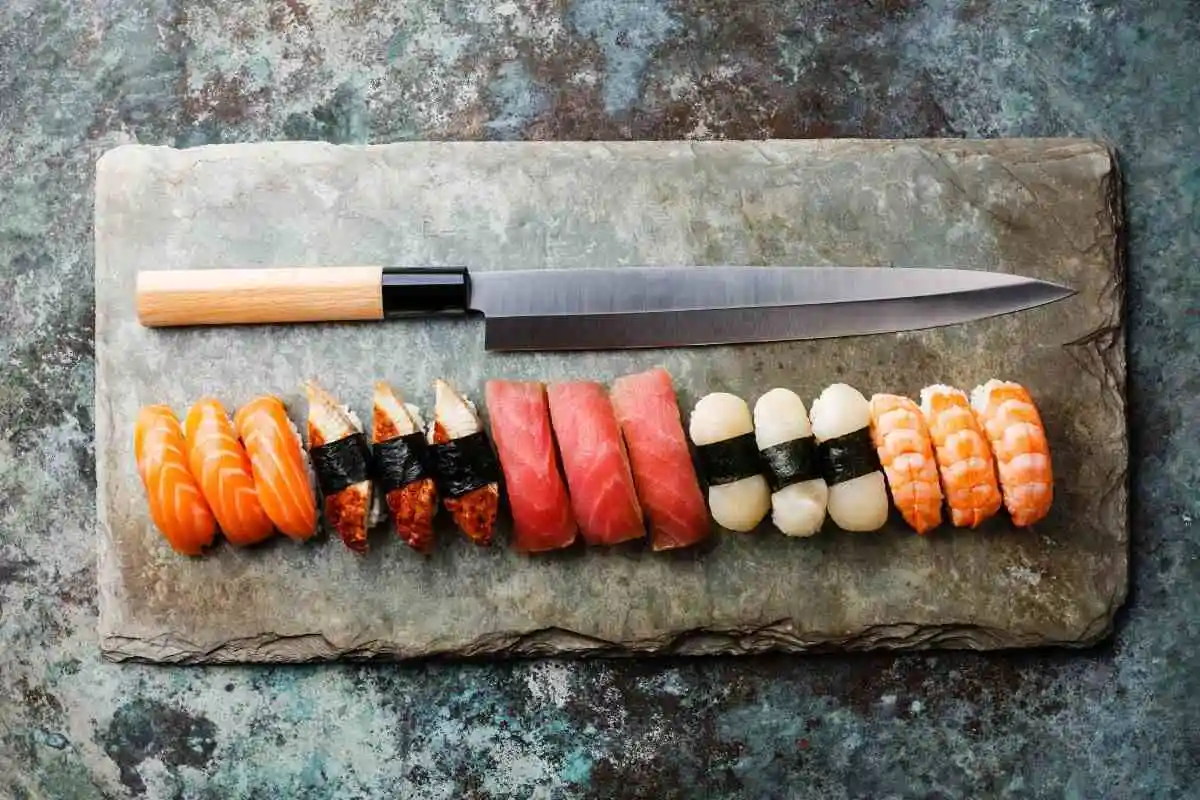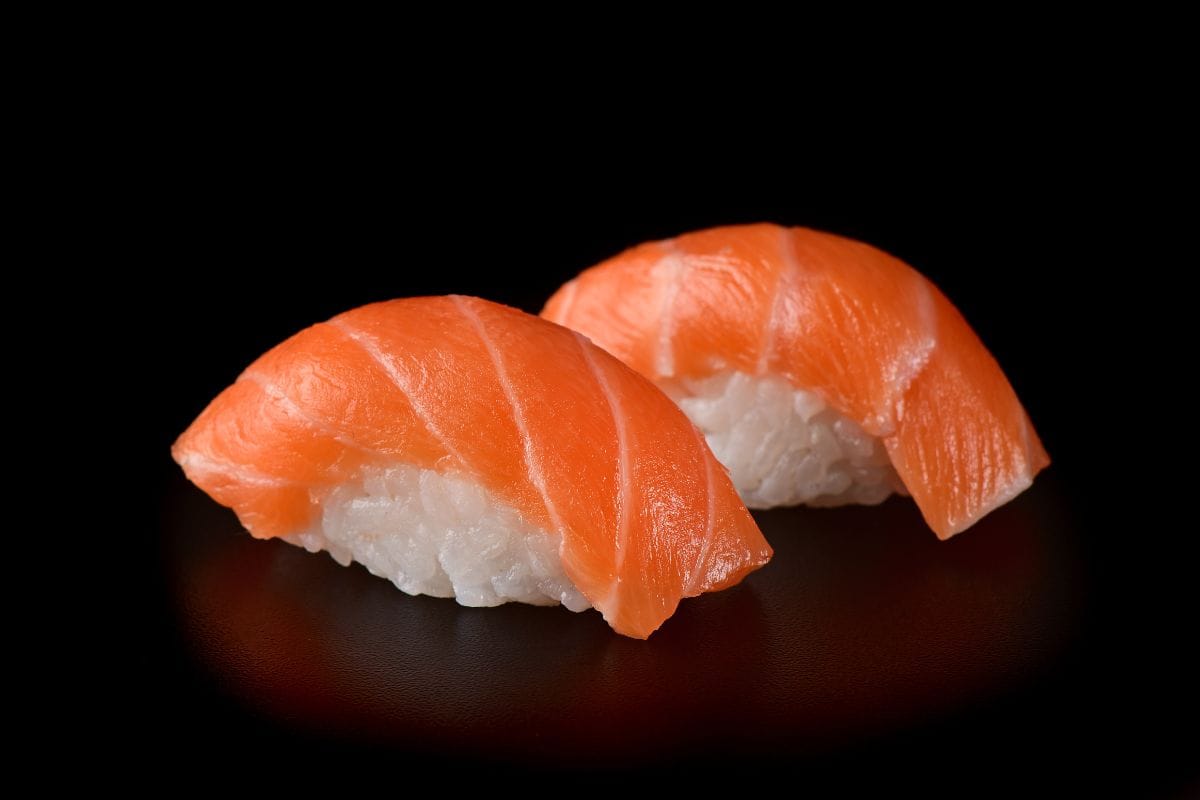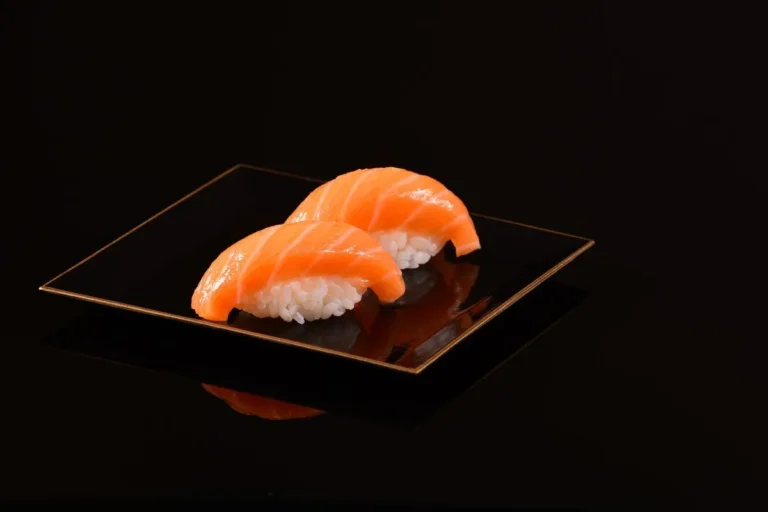Have you ever seen those small, beautiful pieces of sushi topped with fresh fish and wondered, “What’s the secret behind this masterpiece?” Well, you’re about to discover the magic of nigiri sushi, one of Japan’s most iconic dishes. Whether you’re a sushi enthusiast or a curious beginner, this guide will give you everything you need to know—from its origins to making it at home. Let’s dive in! 🐟🍣
Table of Contents
What is Nigiri Sushi?
Nigiri sushi is simplicity at its finest. It’s a hand-pressed oblong ball of seasoned rice (called shari) topped with a slice of fresh fish or seafood, sometimes held together with a strip of seaweed. Unlike rolls (maki sushi), nigiri focuses on the delicate balance between rice and topping, offering an authentic taste of Japan.
Fun Fact: The word “nigiri” means “to grasp” in Japanese, referring to how the sushi is shaped by hand!
Origins of Nigiri Sushi
Nigiri sushi has a fascinating history. It emerged during the Edo period (1603–1868) in Tokyo (then known as Edo). Back then, it was considered a fast food option, as sushi chefs would prepare it quickly for busy workers. Think of it as the original grab-and-go meal! Today, it’s a gourmet delicacy enjoyed worldwide.
How Nigiri Differs From Other Sushi Types
If you’ve tried sushi rolls, sashimi, or chirashi, you might wonder what makes nigiri unique. The secret lies in its simplicity. Unlike rolls stuffed with various ingredients, nigiri is all about showcasing the topping. Every bite is a celebration of the freshness and flavor of the fish. No fancy tricks—just quality ingredients prepared with care.
Essential Ingredients for Perfect Nigiri Sushi
Before you roll up your sleeves (or should I say press up your sleeves?), let’s talk ingredients. Making nigiri sushi is like building a house—you need a strong foundation. Here’s what you’ll need:
| Ingredient | Quantity |
|---|---|
| Sushi rice (short-grain) | 2 cups |
| Rice vinegar | 1/4 cup |
| Fresh fish (tuna, salmon, shrimp, etc.) | 200g |
| Wasabi | As needed |
| Soy sauce | For dipping |
| Nori (seaweed strips) | Optional |
Choosing the Right Rice for Nigiri
The rice is the heart and soul of nigiri sushi. Always opt for short-grain Japanese sushi rice. It’s starchy and sticky, making it perfect for holding its shape. Once cooked, it’s seasoned with rice vinegar, sugar, and salt to give it that signature tangy-sweet flavor.
Pro Tip: Use a wooden spatula to mix the rice gently, so it doesn’t get mushy!
Selecting Fresh Fish and Toppings
Freshness is non-negotiable. Look for sushi-grade fish (your local fishmonger or Asian market can help). Popular choices include tuna (maguro), salmon (sake), shrimp (ebi), and eel (unagi). If you’re feeling adventurous, try toppings like squid or scallops!
The Role of Wasabi and Soy Sauce
Wasabi isn’t just for a spicy kick—it acts as a natural antibacterial and enhances the fish’s flavor. Soy sauce is the final touch, but don’t drown your nigiri in it. Just a light dip will do!
“Sushi is an art form, and nigiri is its simplest, most elegant expression.”
How to Make Nigiri Sushi at Home: Step-by-Step Guide
Ready to become a sushi chef in your own kitchen? Don’t worry—you don’t need years of training to master nigiri sushi. With the right ingredients and a little patience, you can create delicious, Instagram-worthy nigiri that rivals your favorite sushi restaurant. Let’s break it down step by step. 🍣
Step 1: Preparing the Sushi Rice
The key to great nigiri is perfectly seasoned rice. Here’s how to do it:
- Rinse 2 cups of sushi rice under cold water until the water runs clear. This removes excess starch.
- Cook the rice according to the package instructions using a rice cooker or stovetop.
- While the rice cooks, mix 1/4 cup rice vinegar, 2 tablespoons sugar, and 1 teaspoon salt in a small bowl. Heat gently until dissolved.
- Once the rice is cooked, transfer it to a large wooden or plastic bowl. Add the vinegar mixture and gently fold it in with a wooden spatula.
- Let the rice cool to room temperature. Cover it with a damp towel to keep it moist.
Pro Tip: Don’t refrigerate the rice—it will lose its stickiness!
Step 2: Shaping the Rice Base
Now comes the fun part—shaping the rice! This step requires a light touch and a bit of practice.
- Wet your hands with water to prevent the rice from sticking.
- Scoop about 1 tablespoon of rice and gently press it into an oblong shape, roughly the size of your thumb.
- Don’t squeeze too hard; the rice should hold together but still feel light and airy.
Practice makes perfect, so don’t worry if your first few pieces aren’t picture-perfect!
Step 3: Adding Toppings with Precision
Now it’s time to add the star of the show: the fish.
- Slice your sushi-grade fish into thin, rectangular pieces, about 2 inches long and 1 inch wide.
- Add a small dab of wasabi to the center of each slice. (This step is optional, depending on your spice tolerance!)
- Place the fish on top of the rice, pressing gently to secure it.
- If needed, use a small strip of nori to hold the topping in place.
“Think of nigiri as a tiny sculpture—each piece should be beautiful and balanced.”
Tips for Perfecting Your Nigiri Sushi Technique
Making nigiri might seem tricky at first, but with these tips, you’ll be a pro in no time:
Mastering the Rice-to-Topping Ratio
The ideal nigiri has a balanced ratio of rice to fish. Too much rice can overpower the topping, while too little can make it fall apart. A tablespoon of rice per piece is usually just right.
Knife Skills for Slicing Fish
A sharp knife is your best friend. Use long, smooth strokes to slice the fish, and always cut against the grain for a tender texture. If you’re nervous, practice on vegetables first to get the hang of it!
Common Mistakes and How to Avoid Them
Don’t be discouraged if your first attempt doesn’t go perfectly. Here are a few common problems and their solutions:
- Problem: Rice is too sticky or falls apart.
Solution: Make sure the rice is properly rinsed and cooled before shaping. - Problem: Fish slices are uneven or tear.
Solution: Use a sharp knife and practice your cutting technique. - Problem: Nigiri looks messy.
Solution: Wet your hands before handling the rice, and take your time shaping each piece.

Popular Nigiri Sushi Toppings and Their Flavors
While the classic options like tuna and salmon are always a hit, there’s a whole world of nigiri toppings to explore. Here’s a quick guide:
| Topping | Flavor Profile |
|---|---|
| Tuna (Maguro) | Rich, meaty, and slightly sweet |
| Salmon (Sake) | Buttery and mild |
| Eel (Unagi) | Sweet and smoky, with a soft texture |
| Shrimp (Ebi) | Slightly sweet, with a firm bite |
| Scallop (Hotate) | Delicate and sweet |
Feeling adventurous? Try unique toppings like sea urchin (uni) or mackerel (saba). Each brings its own unique twist to the nigiri experience!
“Every piece of nigiri is a tiny journey through flavor.”
Health Benefits of Nigiri Sushi
Did you know that nigiri sushi isn’t just delicious—it’s also packed with health benefits? Let’s break down why this Japanese delicacy is a great choice for your body and soul. 🥢
Nutritional Value of Fish and Rice
The two main components of nigiri—fish and rice—are nutritional powerhouses. Fresh fish is rich in omega-3 fatty acids, which are essential for brain health and heart function. Sushi rice provides carbohydrates for energy, making nigiri a well-balanced meal in just a few bites!
Pro Tip: Opt for toppings like tuna and salmon for an extra dose of protein and healthy fats.
Low-Calorie, High-Protein Snack
If you’re watching your calorie intake, nigiri sushi is a great option. A typical piece contains only 50–70 calories, depending on the topping. It’s also high in protein, keeping you full and satisfied without weighing you down.
Rich in Vitamins and Minerals
Many nigiri toppings, like shrimp and scallops, are loaded with vitamins B12 and D, as well as minerals like selenium and iodine. These nutrients are essential for maintaining energy levels and a healthy immune system.
Nigiri Sushi Etiquette: Dos and Don’ts
Eating nigiri sushi isn’t just about the taste—it’s also a cultural experience. Knowing proper sushi etiquette will enhance your enjoyment and show respect for the art of sushi-making.
How to Eat Nigiri Sushi the Traditional Way
- Pick up the nigiri with your fingers (yes, it’s perfectly acceptable!). Chopsticks are optional but can be used if you prefer.
- Turn the nigiri on its side and dip the fish side lightly into soy sauce. Avoid soaking the rice—it will fall apart!
- Place the entire piece in your mouth for the full flavor experience.
Did You Know? Dipping rice into soy sauce is considered a faux pas in Japan because it masks the chef’s carefully crafted flavors.
Proper Use of Wasabi and Soy Sauce
If the chef has already added wasabi to the nigiri, there’s no need to add more. Too much soy sauce or wasabi can overpower the delicate balance of flavors. Less is more!
The Challenges of Making Nigiri Sushi and Solutions
Even experienced home chefs encounter challenges when making nigiri sushi. Here are some common problems and how to fix them:
Problem: Sticky Rice Not Holding Shape
One of the most common issues is rice that’s too sticky or too dry, making it hard to form the base.
- Solution: Rinse the rice thoroughly before cooking to remove excess starch. Use the right water-to-rice ratio and season it evenly after cooking.
Problem: Fish Slices Falling Apart
Fresh fish can be delicate, and improper slicing techniques can lead to uneven or torn pieces.
- Solution: Use a very sharp knife and slice the fish against the grain. Chill the fish slightly before cutting for better firmness.
Problem: Uneven or Messy Presentation
Creating perfectly shaped nigiri takes practice, and early attempts might look less than ideal.
- Solution: Take your time shaping the rice and placing the toppings. Wet your hands frequently to prevent sticking.

Exploring Regional Variations of Nigiri Sushi
Nigiri sushi isn’t a one-size-fits-all dish. Regional variations in Japan and beyond offer unique takes on this classic favorite.
Edo-Style vs. Osaka-Style Sushi
Edo-style nigiri (originating from Tokyo) emphasizes fresh, raw toppings and simplicity. In contrast, Osaka-style sushi often incorporates cured or marinated fish, offering a more robust flavor profile.
Modern Twists on Traditional Nigiri
Chefs worldwide have put their own spin on nigiri, using unconventional toppings like seared foie gras, truffle oil, or even fruit slices. While purists might raise an eyebrow, these creative interpretations have expanded the appeal of nigiri sushi.
Where to Find the Best Nigiri Sushi Around the World
If making nigiri at home isn’t your style, don’t worry—you can still enjoy the best of the best at renowned sushi restaurants.
Top Sushi Restaurants in Japan
Japan is the ultimate destination for authentic nigiri. Sushi Saito in Tokyo and Sukiyabashi Jiro (of Jiro Dreams of Sushi fame) are two must-visit spots for sushi lovers.
Nigiri Sushi Hotspots in Other Countries
Craving world-class nigiri outside of Japan? Check out Sushi Nakazawa in New York City or Urasawa in Los Angeles. These establishments blend traditional techniques with local ingredients for a unique dining experience.
Conclusion: The Timeless Appeal of Nigiri Sushi
Whether you’re savoring it at a Michelin-starred restaurant or crafting it in your kitchen, nigiri sushi offers a perfect balance of simplicity and sophistication. It’s more than just food—it’s a connection to Japanese culture and tradition. So why not give it a try? You might just discover your new favorite dish. 🍣✨
Unique and Exotic Toppings to Try
If you’re feeling adventurous, toppings like sea urchin (uni) or tobiko can add an exciting twist to your nigiri. Tobiko, in particular, stands out for its delicate flavor and delightful crunch, making it a favorite in Japanese cuisine. To dive deeper into the world of tobiko and learn how to use it in your recipes, check out our detailed guide on everything you need to know about tobiko! 🐟🍣

